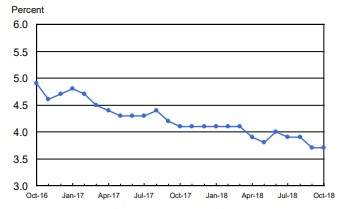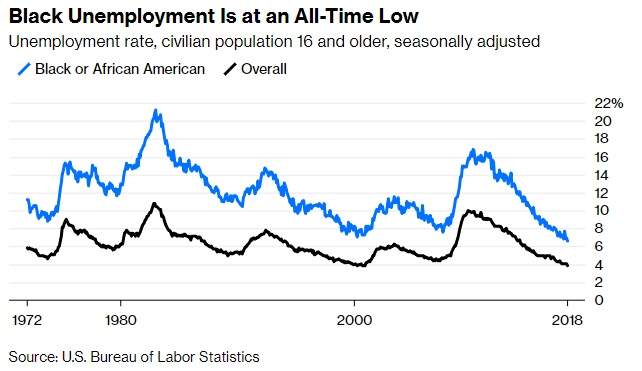Unemployment among Black and Hispanic Communities
| ✓ Paper Type: Free Assignment | ✓ Study Level: University / Undergraduate |
| ✓ Wordcount: 1642 words | ✓ Published: 12 Aug 2019 |
Introduction
What is unemployment and more importantly, how does the rate of unemployment affect our economy? Focus Economics defines unemployment as “unemployed workers in the total labor force” (Focus Economics). You see, unused labor force offers spare resources in our economy that otherwise could contribute production of goods or services to the consumers. This rate of unemployment is volatile and fluctuates according to our economy and current demand. For example, when the economy is strong and consumers are demanding more goods and services, companies will increase capacity for production which in part leads to hiring more workers. On the other hand, when consumer demand is low, production of those same goods and services will decrease which could lead to lower employment within a given industry.
Economy and unemployment rates are also affected by wage growth or decline. During times of expansion, competition for personnel in the labor force can help to generate higher real wages for employees. In contrast, during recessions or trough periods of the business cycle, wages can become stagnant and result in layoffs. As our text book describes, “On the other hand, workers deeply resent pay cuts. So if the economy goes into a recession and firms need to reduce labor costs, managers almost never cut wages because doing so would only lead to disgruntled employees, low productivity, and—in extreme cases—workers stealing supplies or actively sabotaging their own firms.” (McConnell, Brue, & Flynn, 2018).
Currently, the U.S. unemployment rate sits at 3.7 as outlined by the U.S. Bureau of Labor and Statistics which released its latest monthly findings on 2 November 2018 (U.S. Bureau of Labor Statistics 2018). The unemployment rate was unchanged from last month’s findings and has gradually decreased from this time last year from ~4.9% to 3.7% as indicated by Figure 1 below provided by U.S. Bureau of Labor Statistics.

Figure 1: Unemployment Rate. Adapted from “News Release, Bureau of Labor Statistics”, 2 November 2018, p. 1.
In this case study, I will be discussing how the unemployment rate among Black and Hispanic communities has been on the decline allowing more minority participation within the workforce.
Data
Now Gross Domestic Product is a good indicator of how the U.S. economy is performing. The performance of our economy is particularly important to the unemployment rate in that during expansions, firms and business are producing more goods and services and therefore looking for more resources to assist in producing that labor. One of important resources are jobs. There is a theoretical law called Okun’s law that theorizes that for every 1 percent drop in GDP,
As the figure 2, obtained from BEA.gov, below shows, the GDP has been on a steady incline since 2008 (Gross Domestic Product, 2018). In 2008, the U.S. GDP was at 14,712.8 billion. This number has grown to a staggering 19,485.4 billion by 2017. A gain of ~5,000 billion in 10 years.

Figure 2: Gross Domestic Product. Adapted from “BEA.gov”, Table 1.1.5 Gross Domestic Product
Though 2008 and 2009 took a dip in total US GDP, this rise of GDP rate since 2009 displays our prolonged expansion of our economy since the small recession we saw during 2008 and 2009. Figure 3 below shows a percentage breakdown of the GDP growth we have seen since 2008 (Contributions to Percent Change in Gross Domestic Product, 2018). Since 2008, our economy has seen an increase of GDP at a 1.7% average per year. While this isn’t the rate of expansion we have witnessed in previous years, this is a sign of greater economic opportunity and ability for greater job creation and labor force participation.

Figure 3: Gross Domestic Product Percent Change. Adapted from “BEA.gov”, Table 1.1.2 Contributions to Percent Change in GDP
Per Bureau of Labor Statistics, in 2007, the black community had a total of 27,485,000 persons in the civilian non-institutional population (Labor Force Characteristics by Race and Ethnicity, 2007). The non-institutional population is defined as people between the ages of 16 and older not in a correctional institution or part of the armed services. Of the total civilian non-institutional population in 2007, the participation rate was 63.7. Lowest amongst Asians (66.5), Hispanics (68.8), and Whites (66.4). That same year, there was a total of 1,445,000 black people unemployed. This came out to be an unemployment rate of 8.3. This unemployment rate was considerably higher than other ethnicities almost doubling as compared to some. That same year the other ethnicities among Asians (3.2), Hispanics (5.6), and Whites (4.1) was much lower than that of the black community.
However, as of June 2018, the unemployment rate among the black community looks exponentially better. Per Bureau of Labor Statistics, the non-institutional population among the black community has risen to 32,737,000 as compared to ~27,000,000 10 years prior (Employment News Release, 2018). Now the participation rate among the black community declined to 62.2 as compared to 63.7 10 years prior. However, this rate of 62.2 is in line with most other ethnicities, White (62.9), Asians (63.6), only trailing Hispanics (66.5) by a larger margin as experienced 10 years ago. Also, while the unemployment rate among the black community trails other ethnicities, it has declined to 6.6 which is lowest unemployment rate among the black community since the data started being tracked in 1972.
Figure 4 below, provided by U.S. Bureau of Labor Statistics, shows the progressive decline in black unemployment 2010 (Fox, 2018). While black unemployment has consistently trailed other ethnicities unemployment rate and the overall US unemployment rate, it has shown a steady decline to its current lowest ever recorded.

Figure 4: Black Unemployment Timeline. Adapted from “Black Unemployment at all-time low”, 4 May 2018
Analysis
GDP and unemployment rates are inextricably connected. There are many factors that affect unemployment rates, but a consistent is how well our economy is performing and growth of production. This increase in production will require many resources, but most importantly to the unemployment rate is the labor resource. This increase in production and the procurement of goods and services by both the private sector and government usually leads to increases in GDP. However, the same association can be made when our economy is under performing. When riding a recession during the business cycle, production slows. The same firms or companies are not creating goods and services at the same rate and require to pull back on resources to minimize decrease in costs. This will lead to rises in unemployment rates as employees are laid off, rather than cutting back pay.
While the black community has consistently held some of the highest unemployment rates among the U.S. population, they have seen considerable favorable unemployment numbers continue to lower since its recent spike in 2010 at 15.3%. Since then, the black community unemployment rate has continue to drop to its current state (and all-time low since being measured) of 6.6%. Likewise, the GDP has continued to increase annually. During the same time frame (2010 – current), the GDP has continued to increase at an average rate of 2.2%. While it’s good that our economy is performing so well and black unemployment is at an all-time low, it is still concerning how the black community unemployment rate continues to be among the highest among different ethnicities in the U.S.
Conclusion
Based off the fact that the GDP has steadily increased and unemployment among all ethnicities has steadily decreased, it would seem that the government policies are advantageous to our economy and has strengthened our citizens’ ability to get jobs and maintain them. However, one factor that has significantly impacted the unemployment rate is not good and that is the labor participation rate. This has remained stagnant over the last 10 years and has not shown signs of significantly decreasing. Maximizing our labor force is a key component of a strong economy.
There are a few ways in which governments and businesses can invest in maximizes our labor force. One would be to make education more affordable. Currently rates of college tuition are astronomical and usually leads to graduating students maintaining large amounts of debt. If college tuitions, vocational schools, etc were less costly, this may give unemployed force confidence in being able to attend additional education classes in hopes of attaining employment afterward. Also, overhauling the large national safety net programs could help to promote a bit more self-reliance. This would help to incentive low-income families to get back to work to make ends meet. Adding work requirements to these safety net programs could also help to stimulate labor participation. Though Temporary Assistance for Needy Families (TANF) adopted work requirements for welfare, many states do not require this work participation in order to obtain welfare. Putting more stringent work requirements in these programs would require more able bodied laborers to enter the work force thus raising the labor participation rate.
In short, unemployment is continually lowering and has lowered significantly among the black community in the past 10 years. However, there is still more work to do lower these rates and increase our labor participation rate within our economy to truly acquire a stronger U.S. and world economy.
References
Focus Economics. (n.d.). What is the Unemployment Rate. Retrieved November 25, 2018, from https://www.focus-economics.com/economic-indicator/unemployment-rate
McConnell, C. R., Brue, S. L., & Flynn, S. M. (2018). Economics (21st ed.). Retrieved November 25, 2018, from https://online.vitalsource.com/#/books/9781259915666/cfi/6/2!/4/2/2@0:0
U.S Bureau of Labor Statistics (2018, November 2). The Employment Situation – October 2018. Retrieved November 25, 2018, from https://www.bls.gov/news.release/pdf/empsit.pdf
Labor Force Characteristics by Race and Ethnicity, 2007. (2007, September). Retrieved November 27, 2018, from https://www.bls.gov/opub/reports/race-and-ethnicity/archive/race_ethnicity_2007.pdf
Employment Situation News Release. (2018, July 6). Bureau of Labor Statistics. Retrieved November 27, 2018, from https://www.bls.gov/news.release/archives/empsit_07062018.htm
Gross Domestic Product. (n.d.). Retrieved November 27, 2018, from https://apps.bea.gov/iTable/iTable.cfm?reqid=19&step=2#reqid=19&step=2&isuri=1&1921=survey
Contributions to Percent Change in Gross Domestic Product. (n.d.). Retrieved November 27, 2018, from https://apps.bea.gov/iTable/iTable.cfm?reqid=19&step=2#reqid=19&step=2&isuri=1&1921=survey
Fox, J. (2018, May 4). Black Unemployment at an all-time low..But. Retrieved November 27, 2018, from https://www.bloomberg.com/opinion/articles/2018-05-04/black-unemployment-is-at-an-all-time-low-but-there-s-a-catch
Cite This Work
To export a reference to this article please select a referencing stye below:
Related Services
View allDMCA / Removal Request
If you are the original writer of this assignment and no longer wish to have your work published on UKEssays.com then please click the following link to email our support team:
Request essay removal



